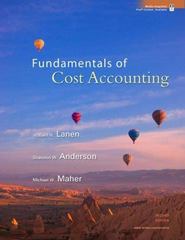g Transfer the cost of the 5,000 cases of synthetic motor oil produced in May to Finished Goods. h Close any over- or underapplied overhead to Cost of Goods Sold. So what? What might have caused these variances? Who might be responsible? What questions would this bring up, and who might have the answers? Journal Entries: Materials Price Variance = Actual Quantity Used x 11 11 11 Standard Price - Actual Price) d. Entry to charge materials to production: 16,500.00 x 1.30 1.25 Work in Process Inventory 21,125 16,500.00 x 0.05 Materials Quantity Variance 325 825.00 Favorable Materials Price Variance 825 Direct Materials Inventory 20.625 Materials Quantity Variance = Standard Price x (Standard Quantity - Actual Quantity) To record the cost of direct materials charged to production 1.30 x 16,250.00 - 16,500.00 1.30 x (250.00) (325.00) Unfavorable e. Entry to charge direct labor to production: Labor Rate Variance Actual Hours Used X (Standard Rate - Actual Rate) Work in Process Inventory 60,000 4,200.00 X 16.00 15.00 Labor Efficiency Variance 4,200.00 x 1.00 Labor Rate Variance 4,200.00 Favorable Direct Labor To record the cost of direct labor charged to production. Labor Hours Variance 11 11 11 11 Standard Rate x (Standard Hours - Actual Hours) 16.00 X 3,750.00 4,200.00 16.00 X (450.00) (7,200.00) Unfavorable Overhead Spending Variance = Budgeted OH at actual production Level Actual OH f. Entry to charge overhead to production: Fixed = 2,600.00 2,200.00Slick Corporation is a small producer of synthetic motor oil. During May, the company produced 5,000 cases of lubricant. Each case contains 12 quarts of synthetic oil. To achieve this level of production, Slick purchased and used 16,500 gallons of direct materials at a cost of $20,625. It also incurred average direct labor costs of $15 per hour for the 4,200 hours worked in May by its production personnel. Manufacturing overhead for the month totaled $9,950, of which $2,200 was considered fixed. Slick's standard cost information for each case of synthetic motor oil is as follows. Direct materials standard price 1.30 per gallon Standard quantity allowed per case 3.25 gallons Direct labor standard rate 16.00 per hour Standard hours allowed per case 0.75 direct labor hours Fixed overhead budgeted 2,600 per month Normal level of production 5,200 cases per month Variable overhead application rate 1.50 per case Fixed overhead application rate ($2,600 = 5,200 cases) 0.50 per case Total overhead application rate 2.00 per case Instructions a Compute the materials price and quantity variances. b Compute the labor rate and efficiency variances c Compute the manufacturing overhead spending and volume variances Prepare the journal entries to: d Charge materials (at standard) to Work in Process Charge direct labor (at standard) to Work in Process. f Charge manufacturing overhead (at standard) to Work in Process.C. Overhead Spending Variance = Budgeted OH at actual production Level Actual OH f. Entry to charge overhead to production: Fixed 2,600.00 2,200.00 Variable = 7,500.00 7,750.00 Total = 10,100.00 9,950.00 150.00 Favorable Applied OH at Budgeted OH at Overhead Volume Variance = Standard Rate actual production Level Fixed E 2,500.00 2,600.00 synthetic motor oil produced in May to Finished Goods: Variable = 7,500.00 7,500.00 Total = 10,000.00 10,100.00 11 (100.00) Unfavorable So what? What might have caused these variances? Who might be responsible? What questions would this bring up, and who might have the answers? h. Entry to close overapplied overhead to cost of goods sold









